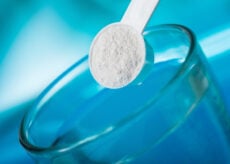Is the Impossible Burger Actually Good For You? (sorry, vegans)

Plant-based companies like Impossible Foods® and Beyond Meat® have created faux “plant-based” burgers designed to appeal to more than just vegetarians and vegans. So much so that I could not even get my hands on one where I live because they were out of stock (and I was dying to try it before I did my deep dive into if the impossible burger is good for you).
This may be the divine intervention that saved my gut.
After doing my due diligence in researching what is so impossible about the Impossible Burger®, I discovered the name probably came about when the creators took their first bite and found it impossible to stomach actually eating them. I am convinced this is a prank gone wrong in that these were never really meant for human consumption, and the joke will be on the consumers when everyone is finally let in on the next reality television show “we actually got them to eat this.” First episode will be the Impossible Burger, with the second show slated to be celery juice. 😉
So, what exactly IS an Impossible Burger?
The Impossible Burger is heme wrapped inside a larger molecule, called leghemoglobin. Heme is a protein that occurs all the time in nature, both in animals and in plants. According to Dr. Kent Kirshenbaum, chemistry professor at New York University, “It’s kind of like a molecular basket that carries iron.” Leghemoglobin is found in soy root nodules, but per the FDA (US Food and Drug Administration), these are not “a commonly consumed human food.”
Both the Impossible Burger and the Beyond Burger® are gaining popularity largely due to folks who are concerned with the environmental or have ethical concerns associated with consuming animals. Both of which are worthy concerns. However, just because these products are considered “plant based” doesn’t necessarily mean they are made from actual plants. I would argue that if you have ethical and environmental concerns, you would fare much better eating directly from your garden.
The Impossible Burger and Beyond Burger are processed foods, and The Impossible Burger relies on ingredients that fall into the category of genetically modified (GMO). This topic could be its own article entirely, so I will save that debate for another time, but I am still on the fence about the safety of consuming GMOs. BioTrust Nutrition goes to great lengths to ensure our products are free from GMOs, and we take pride in using natural ingredients.
The FDA weighed in on the Impossible Burger and stated that it “believes the arguments presented, individually and collectively, do not establish the safety of soy leghemoglobin for consumption, nor do they point to a general recognition of safety.”
The Impossible Burger Company discusses how they create the Impossible Burger on their website:
We genetically engineer yeast to make ‘soy leghemoglobin’ or ‘heme’—one of the key ingredients in the Impossible Burger. This process allows us to make heme at scale with the lowest achievable environmental impact.
“We make heme using a yeast engineered with the gene for soy leghemoglobin. First, we grow yeast via fermentation. Then, we isolate the soy leghemoglobin (containing heme) from the yeast, and add it to the Impossible Burger, where it combines with other micronutrients to create a meaty flavor.
Mmmm “meaty flavor.” Curious about what those “other micronutrients” are? So was I.
Ingredients:
Water, Soy Protein Concentrate, Coconut Oil, Sunflower Oil, Natural Flavors, 2% or less of: Potato Protein, Methylcellulose, Yeast Extract, Cultured Dextrose, Food Starch Modified, Soy Leghemoglobin, Salt, Soy Protein Isolate, Mixed Tocopherols (Vitamin E), Zinc Gluconate, Thiamine Hydrochloride (Vitamin B1), Sodium Ascorbate (Vitamin C), Niacin, Pyridoxine Hydrochloride (Vitamin B6), Riboflavin (Vitamin B2), Vitamin B12.
Impossible Burger Nutrition Facts
If you were able to pronounce all of those ingredients and haven’t yet lost your appetite, follow me as I dig deeper into how these stack up against the competition nutritionally:
The Impossible Burger (3 oz)
- Calories: 220
- Total fat: 13 g
- Saturated fat: 11 g
- Cholesterol: 0 g
- Sodium: 470 mg
- Protein: 21 g
- Iron (Daily Value %): 10%
So, What are the Ingredients In A Beyond Burger?
The ingredients for the Beyond Burger are quite a bit different from the above Impossible Burger. Here’s what it’s made of:
Ingredients:
Water, Pea Protein Isolate*, Expeller-Pressed Canola Oil, Refined Coconut Oil, Contains 2% or less of the following: Cellulose from Bamboo, Methylcellulose, Potato Starch, Natural Flavor, Maltodextrin, Yeast Extract, Salt, Sunflower Oil, Vegetable Glycerin, Dried Yeast, Gum Arabic, Citrus Extract (to protect quality), Ascorbic Acid (to maintain color), Beet Juice Extract (for color), Acetic Acid, Succinic Acid, Modified Food Starch, Annatto (for color).
The Beyond Burger Nutrition Facts (4 oz)
- Calories: 290
- Total fat: 22 g
- Saturated fat: 5 g
- Cholesterol: 0 mg
- Sodium: 450 mg
- Protein: 20 g
- Iron (Daily Value %): 25%
So, What’s Inside a Traditional Beef Burger
And how it compares nutritionally to the “old standard.” Beef.
85% Lean Beef Burger Nutrition Facts (4 oz)
- Calories: 283
- Total fat: 17.5 g
- Saturated fat: 6.7 g
- Cholesterol: 100 g
- Sodium: 82 mg
- Protein: 29.4 g
- Iron (Daily Value %): 16%
So, Is the Impossible Burger Actually Good For You?
While the Beyond Burger is advertised as “The World’s First Plant-Based Burger That Looks, Cooks, and Satisfies Like Beef without GMOS, Soy, or Gluten,” that doesn’t make it any less processed. There are certainly some good points to highlight, such as zero cholesterol and a decent amount of protein, but I am just not sure I am sold on either “alternatives.”
Have you tried an Impossible Burger or a Beyond Burger? Share your feedback on these below.






